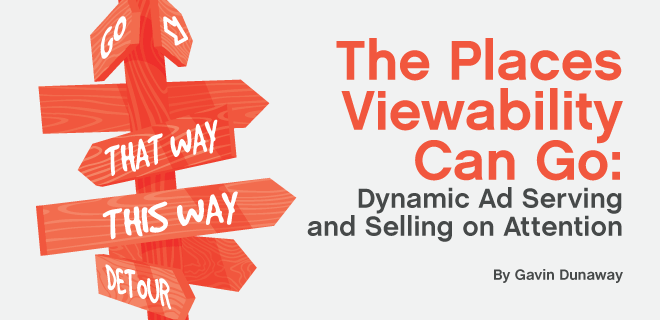
Let’s admit that the majority of headaches when it comes to viewability revolve around the fact that in campaigns it’s measured ex post facto. The ad is served and then the viewability pixels start counting—but the buy and sell side pixels load at different times, causing discrepancies aplenty.
Doesn’t that seem backwards? Sovrn CMO and OnScroll Co-founder Andy Evans certainly thinks so. At the same time, dynamically serving ads in-view opens up measurement possibilities well beyond simple viewability—it creates the opportunity to record that most elusive of metrics, attention.
“The next evolution in viewability is Viewable Engagement Time,” he explains. “Once we understand the ad is in view in real time, we then start counting—not just time, but what we call engagement time. Is the user active? Are they scrolling? Are they touching their screen on their mobile or their tablet device? We’re really trying to understand that the user not only has the ad in view, but that the ad is engaged.”
I sat down with Evans to hear more about the advantages of OnScroll’s dynamic ad serving, how identifying highly engaged users can drive revenue, and the cross-platform potential of buying and selling against engaged time or attention.
GAVIN DUNAWAY: So what makes OnScroll’s technology different from a basic publisher viewability tactic like “lazy loading”?
ANDY EVANS: Lazy loading is not adequate. It will still load by default quite a long way down before a user actually arrives there on a page.
Our script is much more dynamic—looking down to the pixel and even the speed of people scrolling to understand the right time to load an ad unit, particularly because third-party measurement companies have pretty stringent rules on when an ad is in view. Lazy loading gets you part of the way there, but not anywhere near as close as you need to if you want to score high with the buy side.
As we move towards a world where brands will be looking to buy on a cost-per-second or cost-per-hour basis online, we’re already starting to understand and monitor engagement. As a midterm step, we allow publishers to say, “We know the ad is in view and we know it has been actively engaged with for 25 to 30 seconds.”
At that point, the brand opportunity is expired—the click option is the lowest possible opportunity. If we haven’t sold this as sponsored, premium or something like that, we’re going to reload that unit and create ourselves another ad opportunity. Not only is it 100% additive without affecting user experience, we’ve seen 15%-25% more incremental revenue per page.
GD: The term “refresh” is still a bit of a dirty word among both advertisers and publishers, but this is something beyond that.
 AE: “Refresh” is a word I avoid because during my nearly 20 years in this market, it has been used in horrible ways. That really isn’t the right way to look at this—OnScroll’s solution is an engaged reload. If we stop seeing engagement—like a scroll—the counter pauses. When we detect engagement again, it picks back up.
AE: “Refresh” is a word I avoid because during my nearly 20 years in this market, it has been used in horrible ways. That really isn’t the right way to look at this—OnScroll’s solution is an engaged reload. If we stop seeing engagement—like a scroll—the counter pauses. When we detect engagement again, it picks back up.
There are opportunities when this wouldn’t be used, but if you’re selling on the open programmatic market and so on, you want to be able to create opportunities. In the same way scrollers are high-value users, highly engaged users are also very, very valuable, and from early research we don’t see any degradation in terms of the click-through rates and the ROI on the second ad loaded after the first. We’re working on some case studies with brands to demonstrate that now.
GD: If this is the mid-term step, the next one has long fascinated us: the potential for buying on engaged time. What do you see as a path forward to that, or what do you feel are the biggest obstacles preventing buying or selling on a cost-per-second, cost-per-hour basis?
AE: It would be interesting to be able to buy digital advertising in a similar way to radio and television as well as measure them alongside each other and have more universal metrics to help the buy side to do a better job. The Financial Times and The Economist already have done very well selling against time. But these are premium, direct sales, and it takes an awful lot of time, effort and technology to execute.
Ad technology at the moment isn’t really able to deliver that kind of solution, and it’s just not executable from a programmatic perspective. There is talk that in the latest version of OpenRTB, there will be some consideration for a cost-per-second protocol of some kind, which we applaud.
I think that would be really interesting. It’s something that I personally find fascinating and I’d be excited if we could achieve it in the market, because it really seems to make a lot of sense for everybody. If you have highly engaged users and you’re selling them on time, you should be able to get a good premium, and it would be nice to have it measured against radio and television for a more universal advertising platform. Those advertising techniques are all digital anyway, so you’d be buying all of them through a programmatic platform and measuring with the same figures.
We actively talk to our peers in the industry who are doing similar kinds of things: “How can we accelerate this in the market? How do we make it available to buyers?” It’s something that we’re actively pursuing in the background, but the reality is that it’s going to be 18 to 24 months until we really see anything that works
GD: I think you make a great point: OpenRTB support could be a huge leap forward guaranteeing against engaged time.
AE: That will help the buy side start thinking about this—they certainly have an appetite for it. But it’s much like viewability: there was a period when viewability first came to the forefront where there was a lot of talk about it from buyers and sellers, but not much action. We’re going to go through the same thing with time and engagement: there will be a lot of interest in it, but whether people are actually executing on it or whether money being spent around it is another issue.
GD: You brought us back to the current state of viewability. It’s a bit of a mess when it comes to publishers and agencies fighting over every last impression. What frustrates you the most about the current state of the market?
AE: It frustrates me that more publishers aren’t addressing viewability from a dynamic perspective. Retrospectively measuring has a number of values, but when dealing with viewability, there are ways of approaching it more dynamically. Obviously there are solutions in the market, but it still surprises me that not as many are dealing with it as a dynamic solution and from a user perspective.
GD: Do you think one of the reasons for that is advertiser insistence on third-party measurement?
AE: Of course that’s something to deal with. But I think if you’re able to find a proactive and dynamic viewability solution, it will work in tandem with all of those platforms and provide the highest level of scoring.
We talk to measurement providers to understand what’s going on, and we spend a lot of time making sure that our technology is in sync with the rest of the industry—so that when it is being used by publishers and then measured by the demand side, the numbers are coming up they’re supposed to be.